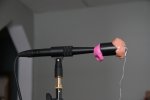On the old forum there was a thread regarding methods for testing custom moulded IEMs. Dave said he got some putty from UE, someone else was talking about a tube adapter and yet another person had a link for an apparatus, but the link is broken now. UE says they don't sell anything like that. The thread was from a while ago and doesn't have any additional information. So...
Has anyone purchased or built a jig that can measure frequency response on custom moulds? Just looking for something to allow tests of IEMs against a known pair or against themselves over time, not for absolute frequency response, but repeatable and consistent measurement.
Thanks!
Has anyone purchased or built a jig that can measure frequency response on custom moulds? Just looking for something to allow tests of IEMs against a known pair or against themselves over time, not for absolute frequency response, but repeatable and consistent measurement.
Thanks!

